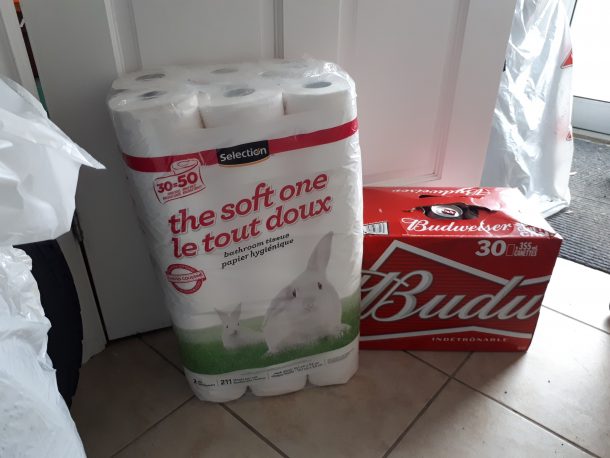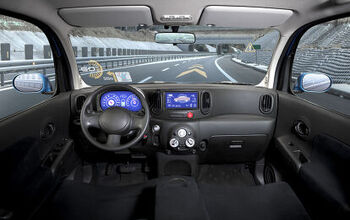Stranger Danger: When Driving Goes Viral

As the resident germophobe here (and everywhere else, now and in the past), spotting bacteria and viruses is no difficult task for this writer. It’s easy — they’re everywhere. The outer layer of your average human surpasses the dirtiness of an adolescent mind.
And it’s with this mindset in tow that your author enters a pandemic. Just freakin’ great. Like most normal, well-adjusted people, I like going to bars and public places every once in a while, and try and stop me from picking the best-looking Roma tomatoes out of that grocery store bin that everyone stands over, pawing at them with their filthy hands. I also put a fair number of miles on my luxurious sedan — a once-innocent practice that now carries its own viral danger.
How can a driver stay safe?
Well, as Linda Lovelace once said, it’s hard. Take the other day, for example.
A week-long trip to a far-flung buddy’s place was cut short by circumstances, one of which was the rapidly changing virus situation there and back home. So, on Tuesday, I drove 960 miles in 15 hours to the relative safety of my well-stocked apartment, ready and prepared to self-isolate.
Observe:
Yes, the essentials are all there.
Between buddy’s place and home lay several stops that couldn’t be avoided: gas stations. One beneficial thing to come from this outbreak is the broad realization that everything a member of the public touches can be contaminated. Like Marxists in academia, viruses thrive everywhere, even at gas stations.
The plan was simple. If I couldn’t pay at the pump (something I normally avoid like the plague), I’d have cash on hand and pay the exact amount in the store, thus avoiding both the debit machine and the pocketing of infected change handed to me from someone who, just maybe, was wrist-deep in his or her nose 2 minutes before I pulled up. (Yes, I could tap the bank card if the machine allowed. It sometimes does not.)
While minimizing — or avoiding — time spent in the store and the interaction with the clerk is good, it’s still necessary to make contact with the pump nozzle. Unlike a toilet flush, dumping a couple dozen gallons of high-test into your tank can’t be accomplished with an elbow or foot. Danger lurks!
According to researchers at the US National Institutes of Health and Rocky Mountain Laboratories (writing in the New England Journal of Medicine), this particular virus can live for up to three days on a plastic or stainless steel surface. Tests are ongoing to determine what ambient temperatures sustain or kill the virus, but let’s assume, in the interest of caution, that in most normal temps this danger enjoys a lifespan approaching 3 days.
Don’t count on UV light, found in sunshine and capable of expediting the virus’ death, to disinfect the surface of the downward-facing trigger, either.
Even if you pay at the pump, you’ll still have to come into contact with the keypad and the pump handle. Using the corner of your wallet can overcome the first hurdle, but you’re on your own for the second, assuming it’s self-serve or nothing. You’ll need to clean that hand before getting back on the road.
How did your cheap and paranoid author navigate this minefield and return home to his selection of low-cost cans? It went like this: If I was paying inside the store, I’d only engage the filler cap, pump handle, and selector button with my right hand. Car keys, by the way, were in my left pocket, accessed by my left hand. Entering the store was accomplished by one finger on the right hand, assuming I couldn’t catch it with my food after a patron’s exit.
Try to keep six feet or more from those patrons.
From there, it was straight to the bathroom to wash my hands. The coronavirus hides its tools inside a lipid outer layer that slides off skin and other surfaces when soap is applied. Wash for 20 seconds, but soap up the tap handle first, as you’re going to have to turn it off when you’re done. Getting out of the bathroom, where doors usually open inward, is easily accomplished with the help of a paper towel (which you can drop into the wastebasket upon leaving) or a piece of your jacket. At that point, you pay via exact cash or tap card. At worst, you’ll have to debit it up and dirty a finger (I sacrifice the pinky) while punching in those keys.
From there, you’re out the door, using your foot, elbow, shoulder, or two fingers pressed into the top left corner of the door (where no one touches). With your clean and unsullied left hand, you grab the keys, unlock the car if necessary, open and close the door, and then awkwardly insert that sucker into the right side of your steering column. Even more luxurious cars (read: not the one seen below) will afford you the luxury of push-button start, so no worries there.
Once inside the car, there’s just one or two fingers to clean — the debit finger, or the two door fingers. This is where an alcohol gel is invaluable. As for the car’s interior, a Lysol wipe works great for sanitizing the brake handle, shift knob, steering wheel, turn signal, wiper stalk, and door handles. Easy stuff, but can you be sure you’ve killed all the (microscopic) bad guys?
Nope. Ever read the instructions on a can of Lysol? You’ll have to make that surface wet for 4 to 10 minutes in order to disinfect, not sanitize. Sanitizing is something you do in your kitchen to avoid salmonella, with the surface staying wet for about 30 seconds. One must disinfect in order to eliminate viruses.
Which means even the interior of your car isn’t fully safe, even after a lemon-scented wipedown. The only solution, the only way to be completely (well, 99.99 percent) sure of safety, is to avoid bringing the virus into the cabin. That means removing as much of it as possible from your hands before entering… and stepping on the gas when the distant form of a hitchhiker appears on the road. Yes, wash those mitts all the time, but treat them like a first date — never assume they’re 100 percent trustworthy. A little paranoia never harmed anyone, but coronavirus will.
Happy carefree driving.
[Images: Nithid Memanee/Shutterstock; Steph Willems]

More by Steph Willems
Latest Car Reviews
Read moreLatest Product Reviews
Read moreRecent Comments
- Bd2 Ultimately, it comes down to price/whether it makes financial sense for buyers (right now, BEVs just aren't there, even with the tax credit). HEVs are finally seeing their place in the sun, decades after being a niche market; this is due to premium for HEVs having narrowed significantly with pure ICE, whereby buyers can recoup that after 2-3 years of ownership.
- MaintenanceCosts I've experienced three cars that were the first year of the model. The two I bought (first-off-the-boat 2004 TSX and midyear 2006 Civic) were both Hondas and were both flawless. The other one was my ex-stepmother's 1990 Land Rover Discovery. It was one of the very first Euro-spec models, a two-door with an asthmatic carbureted 3.5L V8 and a five-speed manual. Every part of the car broke at some point, including things like hatch hinges that really shouldn't break. It turned her off Land Rover forever, and her cars since have all been Subarus.
- MaintenanceCosts When I was living with my Bolt in a rental condo and charging from 120V in the garage, as soon as the association figured out what was happening, they asked me to pay $30 a month to cover the cost. That's pretty close to what I was using so I had no issue with it.
- SCE to AUX I've had mixed results with first-year cars:71 Pinto - good. 85 LeBron GTS - good. 96 Grand Voyager - good. 02 Passat B5.5 - bad. 05 Odyssey - bad. I also had a last-year car that was terrible (80 Bobcat), but most cars were crap then, anyway.
- Crown Go big or go home. Never understood the "economy version" that manufacturers make of a performance car.




































Comments
Join the conversation
Some are really enjoying the fear factor . -Nate
Hope this does not freak people out too much. In a conversation with a doctor, long before the Corona virus, we talked about bacterial infection. Specifically about burn victims who's skin, a main barrier to infection, is damaged. In a discussion of cleaning he told me, "you can never completely eliminate all the bacteria. Only lower the count." The goal is to have so few around on hands and medical equipment that the likely transfer is very low. To repeat what I wrote on another thread at TTAC; I now take several small plastic bags with thick paper towels soaked in alcohol. I wipe everything that I'm going to touch, gas pumps, credit card terminals, door handles, and so on. When I'm ready to leave I wipe the parts of the car with a fresh towel along with my hands. Since the alcohol takes several minutes to evaporate I'm thinking that this is about as effective as I can be. Unless they start putting up level 5 decon facilities everywhere. Also many touch screens do not function with gloves. Use the stylus and in case it is missing bring your own. And lastly, most gas stations in SoCal,even though they sell food and are supposed to have toilets, they are frequently 'busy' or 'closed for cleaning' or otherwise inaccessible. So I do not expect to be able to wash hands until I get home.